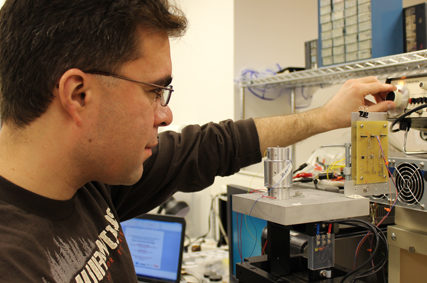James McCullagh receives Best Student Paper Award for research to keep bridges safe
McCullagh is working to develop energy harvesting devices and circuits to power wireless sensor nodes which can monitor bridge health.

 Enlarge
Enlarge
James McCullagh, a doctoral student in electrical engineering, conducts research that has important ramifications on the safety of the nation’s infrastructure, starting with our bridges. He is helping to develop energy harvesting devices and circuits to power wireless sensor nodes which can monitor bridge health.
He recently received a best student paper award for a research paper he presented at the 12th International Workshop on Micro and Nanotechnology for Power Generation and Energy Conversion Applications (PowerMEMS 2012) titled “Short-term and long-term testing of a vibration harvesting system for bridge health monitoring.” The paper was co-authored by Dr. Rebecca L. Peterson, Dr. Tzeno Galchev, Robert Gordenker, Yilan Zhang, Professor Jerome Lynch (Civil and Environmental Engineering), and Professor Khalil Najafi (Chair, Electrical and Computer Engineering). James is advised by Prof. Najafi.
“The nation’s bridges are deteriorating,” stated James. In 2010, the U.S. Department of Transportation rated over 10% of the nation’s bridges as structurally deficient. Wireless sensors can monitor these bridges, however, these structural health monitoring (SHM) sensors may need to be placed in extremely hard to reach places where constantly replacing batteries can be expensive and dangerous. One example of this is under the middle of a large and heavily trafficked suspension bridge covering a significant body of water.”

 Enlarge
Enlarge
“Our group previously introduced the Parametric Frequency Increased Generator (PFIG) in which a large inertial mass snaps back and forth between latching magnets on the springs of two electromagnetic transducers (FIGs). Thus the PFIG converts the low frequency, non-periodic, and low acceleration bridge vibrations into higher frequency mechanical oscillations to be electrically transduced and rectified.”
“Previous generations of PFIG have been temporarily installed on the new Carquinez bridge near Vallejo, California. In these recent tests, an improved PFIG was installed on the new Carquinez bridge, and for the first time a circuit interface was also installed with the PFIG. In short-term tests the power harvested on the bridge is increased by 10x from previous versions. We also installed the PFIG system (PFIG and interface electronics) for a long-term test, and it shows continuous and ongoing harvesting on the bridge for more than 6 months since April 30, 2012.”
This work is supported by the National Institute of Standards and Technology (NIST) Technology Innovation Program (TIP).
About the PowerMEMS Conference
The 12th International Workshop on Micro- and Nano-Technology for Power Generation and Energy Conversion Applications, or PowerMEMS 2012, focuses on all aspects of energy conversion and processing at the micro and nano scales. Its topics of interest range from basic principles, to materials and fabrication, to devices and systems, to applications.
More Info
Read about an earlier generation of the device
Watch a video overview of the NIST TIP project to monitor the structural health of bridges
 MENU
MENU 
